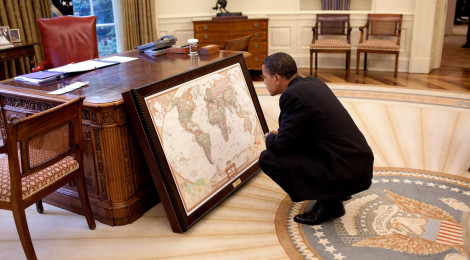Given that it is occurring under the shadow of China’s naval modernization, the Indian Navy’s ongoing modernization is frequently overlooked. Granted, India’s naval modernization pales in comparison to the pace and scope of that of China. Nevertheless, the implications for Indian Ocean affairs as significant as demonstrated when India made a substantial commitment to evacuating its own citizens and other foreign nationals from Yemen.
The Indian Navy plans to control the waters of the Indian Ocean for civilian and military purposes through a strategy of sea control. India’s 2009 Maritime Doctrine asserts that “sea control is the central concept around which the [Indian Navy] is structured, and aircraft carriers are decidedly the most substantial contributors to it.” As such, the Indian Navy’s force structure is not surprisingly, dominated by carrier-centered task forces and surface (ship) action groups.

India’s carrier-centred naval doctrine requires it to have three or more carriers in order to have one carrier-centered combat formation at sea at any time. India has long had only one aircraft carrier in operation, the Centaur-class aircraft carrier Viraat. Originally part of the post-Second World War British Royal Navy, India acquired the Viraat in 1987, flying off it a complement of Sea Harrier fighter aircraft. The Viraat, now 62 years old, is in desperate need of replacement. In 2004, India purchased a mothballed Soviet-built aircraft carrier from Russia, the Vikramaditya, to replace the Viraat. Unfortunately for New Delhi, delays beleaguered the refit of the Vikramaditya, pushing back the commissioning of that ship from 2008 to 2014. With India’s first indigenous carrier, the Vikrant, not expected to be commissioned until 2018 at the earliest and the elderly Viraat due for retirement in 2016, India will experience a shortfall in aircraft carriers.
The required third aircraft carrier is to be Vishal, another indigenous carrier not expected to be ready until 2025 at the earliest. By 2030, India should have at least three carriers in service, allowing the Indian Navy to constantly keep one carrier-centered formation at sea. At the same time, the Indian Navy faces the challenges posed by have three distinct carriers. This results in reduced interoperability, particularly for the onboard air wings. Moreover, the emphasis on having one deployable carrier-centered task force at any time taxes India’s relatively small surface naval combatant fleet as each carrier will at the very least require 1-2 destroyers and 2 or more frigates as escorts. In addition, the carrier group will involve support vessels and, ideally, at least one nuclear-powered attack submarine.
While carrier-centred forces are the Indian Navy’s aspiration, at present the fleet is heavily dominated by surface combatants. India currently has nine destroyers in service and appears to be aiming for a total force of ten. The destroyers’ main tasks will be to provide long-range air defence capabilities to defend aircraft carriers and other task forces. Eight of India’s nine in-service destroyers have been in service for at least a decade with the average service of 25 years. To ameliorate this situation, India has commissioned the first of three Kolkata-class destroyers. The remaining two ships should be in service by the end of 2016 to replace some of the aging Rajput-class destroyers. The Kolkata-class ships constitute India’s most modern warship to be indigenously produced. Nevertheless, many of the Kolkata-class’ critical systems are imported, including its propulsion, air search/engagement radar, and its air-defence missiles. A further four derivates of the Kolkata-class, the Visakhapatnam-class, are planned to be commissioned by 2025, replacing the last remaining Rajput-class vessel that will be 37-year old. By 2025, based on currently announced procurement plans, the Indian Navy should have a fleet of ten destroyers in service.
To supplement its destroyer fleet, India has a 15-ship strong frigate fleet. While frigates are generally less capable than destroyers, India’s frigate fleet is of much more recent development, with an average age of 12 years. Of these fifteen, only three have been commissioned for more than 15 years. As such, they tend to have more sophisticated sensors and armaments. The work-horse of the Indian frigate fleet are the six Russian-built Talwar-class frigates commissioned between 2003 and 2013. India has also built an indigenous class of frigates, the Shivalik-class. That said, many of the Talwar-class’ systems, including propulsion, air search radar and armament are imported. Though three Shivalik-class vessels have been built and the class deemed a success, they each spent almost seven years pier-side being fitted before being commissioned. Nevertheless, no less than seven new P-17A frigates are being built, an evolution of the Shivalik-class. Based on publicly known procurement plans, the Indian Navy should eventually have a fleet of approximately 16 frigates.

In addition to multirole warships, India has a substantial fleet of relatively small corvettes and missile boats dedicated to anti-ship warfare. Of note are India’s most recent additions to its navy, the Karmota-class anti-submarine warfare ship. These light frigate-sized single-purpose ships, though vulnerable to enemy air and surface combatants, can greatly improve India’s anti-submarine capabilities. Currently one ship is in service, three ships are under construction and a further eight are planned. Though India has a coast guard, the Indian Navy has prudently invested in its own patrol vessels in the form of the Saryu-class vessels. These light frigate-sized ships are minimally armed, leaving them only suitable for enforcing India’s maritime rights, engaging in anti-piracy operations and patrolling India’s maritime borders. Four Saryu-class vessels are in service with a further five ships planned. The Saryu-class frees up India’s more capable multi-role warships for other tasks, therefore becoming a force multiplier to the Indian Navy.
India’s ongoing naval modernization program does not match the pace or scope of China’s remarkable naval modernization New Delhi is developing capabilities tailored to attaining sea control in the Indian Ocean. Whether India meets this goal depends not only on India’s own resource commitments and priorities but also the efforts of India’s rivals and neighbours. Nevertheless, the Indian Navy is showing progress in modernizing its surface combatant force.




